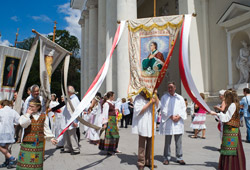History
The first known pilgrimage in Lithuania involved a solemn procession from Vilnius in 1604 to pray before a miraculous painting of the Mother of God at Trakai. Pilgrims of the 17th century flocked to shrines with images that were considered miraculous. In the 18th and 19th centuries, the Gate of Dawn became the most popular pilgrimage destination for Catholic and Orthodox Christians in Lithuania, Latvia, Belarus and the northern part of Poland. The fame of some paintings spread far and wide, and people often left gold or silver items beside them as tokens of gratitude for graces received. The precious metals in these votive offerings (or ‘ex-votos’) were often used to fashion ornate, artistic covers for the paintings. The most eminent images of the Blessed Virgin Mary were solemnly crowned. In fact, the tradition of crowning beloved paintings of Mary continues in Lithuania even today.
Among famous Marian images in Lithuania: the Trakai Mother of God was crowned in 1718 and has long been honoured as “Protectress of Lithuania”; the Sapiega Madonna in Vilnius Cathedral was crowned in 1750; Our Lady of Šiluva, known as “Health of the Sick”, was crowned in 1786; the Dawn Gate Mother of Mercy was crowned in 1927; the Pivašiūnai Mother of God was crowned in 1989 and given the title “Comfort of the Afflicted”; and the Samogitian Calvary image of Mary, Queen of the Christian Family, was crowned in 2006.
Besides miraculous images, shrines recalling the sufferings of Christ the Saviour also attracted great numbers of devout souls. Because pilgrimages to the Holy Land were almost impossible in the era of the GDL, the central places related to the Saviour’s Passion were, as it were, reconstructed locally so that believers could access them. Bishop Jurgis Tiškevičius of Samogitia established the first such “Calvary” in the GDL in 1639, in the town of Gardai. He even wanted to rename the place New Jerusalem, but another name took hold: Samogitian Calvary. It is a Way of the Cross in the Dominican tradition with 20 stations. Vilnius Calvary, founded by Bishop Jurgis Bialozoras, was inaugurated in 1664 in Verkiai. It is also of Dominican style. The Pilgrim Route of John Paul II also includes a Franciscan-style Way of the Cross with 39 stations at the Tytuvėnai Bernardine monastery complex. This form of piety, which awakens pilgrims’ thoughts, feelings and imagination, and which demands perseverance and effort, is still popular in Lithuania.
Among the many famous shrines in Lithuania, Šiluva clearly stands out. Historically, pilgrims have been drawn to Šiluva not only by its miraculous image of the Mother of God, but also because it is the site of an apparition of the Blessed Virgin Mary.
Often people set off to visit particular shrines motivated by miracles which they themselves or others had witnessed. Most commonly, these were conversions and spiritual or physical healings. The pilgrims hoped to win the same special graces for themselves or for loved ones. Trips to some sanctuaries were also prompted by the hope of earning an indulgence – the remission of part or all of the punishment due for sins through the Church’s ministry.
The natural development of pilgrimage traditions in Lithuania was disrupted during most of the 19th and 20th centuries by foreign occupations. Following an uprising in 1863, the Tsarist regime banned group travel to shrines as well as processions, erecting crosses and other organized manifestations of faith. These prohibitions greatly reduced the scale of pilgrimages, which continued, but became more of an individual than a group undertaking. Many people were clever enough to get around the official prohibitions, or simply ignored them. During the Soviet occupation, any public expression of religiosity was strictly forbidden. People who took part in pilgrimages, and all the more so those who organized them, risked severe punishments. While the pious traditions did not perish, such persecution certainly led to reduced participation in them. After all, things like joining a religious procession, attending feast day services at a shrine or setting up a wayside cross could mean the loss of one’s job, expulsion from university, and even prison or exile. Clearly then, Soviet-era pilgrims were witnesses of faith. Some were even ready to accept martyrdom for the Lord. The Hill of Crosses is an excellent illustration of how people firmly persevered in their faith during the Soviet years. Lithuanians dispersed to other parts of the world created their own traditions of pilgrimage. They also travelled to Rome for the fifth centenary of St. Casimir’s death and for the 600-year jubilee of Lithuania’s Christianization.







